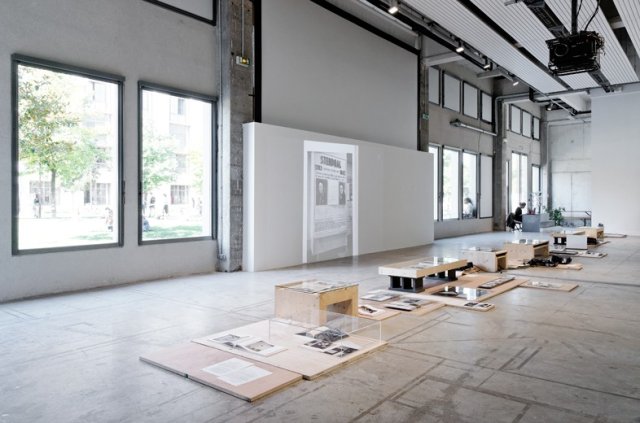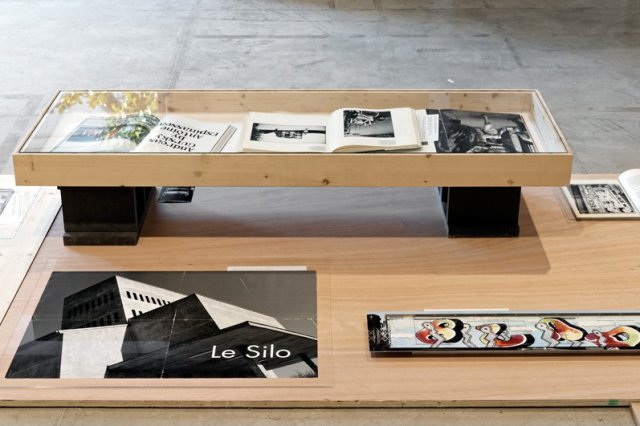They remember only the photographs

- Exhibition view "They remember only the photographs". Bétonsalon - Center for art and research, Paris, 2013. © Aurélien Mole
"They remember only the photographs [1]" is a publication / exhibition, resulting from the collaborative work between the Ecole du Louvre students of the research group "Modern and contemporary art photographed" and the University Paris Diderot - Paris 7, represented by five students from the association Politik’art. Entrusted to graphic designers François Havegeer and Sacha Léopold, known as Syndicat, the project focuses on scientific research and operates as a reflexive process in progress. It represents the research undertaken at the Bibliothèque Kandinsky (Centre Pompidou MNAM-CCI) by ten students from the Ecole du Louvre Masters degree. This year, under the co-direction of Didier Schulmann, head curator of the Bibliothèque Kandinsky, and Remi Parcollet, post-doctorate candidate at the Labex "Création, Arts et Patrimoine".
In her last book, Regarding the Pain of Others (2003), Susan Sontag questions the effect of photography on our perception of historical and contemporary events. "They remember only the photographs" is a reference from one the essayist’s quotes that underlines this particular, although rarely addressed, perceptual phenomenon : the moment where the memory of representation is added to the memory of the event, at the risk of erasing it.
The arrival of photography and its role in reproducing art works, or understanding artistic practices has blurred our points of reference. Moreover, today it would seem that the modern and contemporary art archive is freeing itself from its purely documentary status. As a result of art’s conceptual and processual evolution, notably dating from the 1960s, document’s status borders on that of artwork, particularly thanks to photography.
This exhibition-publication aims to materialize a reflection not only on the practice and production of the documentary image, but rather and foremost on the archive, its uses, the diffusion and reception of these photographs. It strives to question the journey of the photos and the circulation of artwork and artistic practices, through the use of different supports (photographic printing, printed photographs, books, catalogues, magazines, revues, invitation cards, posters, post cards, digital images…).
It is a question of identifying the causes and the mechanisms of the process of cultural heritage through photographing exhibitions and the works on show and ephemeral, immaterial, or in-situ artistic practices. For if photographs of exhibition views, workshops, performance, dance or even fashion are called upon to fully integrate photographic heritage, they also open up a field in which we question art history and criticism methods, and the practices of museographers and curators. Digital campaigns are gradually developing and these photographic archives are being confronted with new stakes, not only in terms of preservation but also in terms of diffusion and enhancement. What are the consequences of this in artistic, scientific and educational terms?
Sociologically speaking, digital technology makes the hitherto theoretical link between Pierre Bourdieu’s two canonic analyses, rational: one on photography, « Un art moyen » (1965) and the other on museums « L’amour de l’art » (1966). Digital technology, when faced with artworks and museums, modifies the respective ways that the public, students, institutions and artists themselves use photography.
Among the different documents that are linked to and provide insight into the exhibition, photography is clearly dominant. In fact, it occupies a strong place in many of the recent publications about the history of exhibitions. Institutional archives such as that of the Venice Biennial or documenta in Kassel, are becoming increasingly accessible and provide historians with a re-reading of art history, and more specifically the history of exhibitions. Featured are key figures, privileged witnesses of these events, such as the photographers Ugo Mulas or Gunther Becker, the latter who developed a rigorous
documentary style similar to that of Bernd and Hilla Becher. The subjectivities of the authors call for precaution and discernment, as illustrated by the implication of the young Reiner Ruthenbeck when documenting Düsseldorf’s artistic scene at the start of the 1960s. Today, the status of his revisited images must be reconsidered, in regard to his work as a sculptor. In the same way, today Mulas is considered a precursor of photoconceptualism, thanks to his series of “verifications” produced at the end of his life, in the early 1970s. 40 years later, these were displayed in museums alongside artists
from the Arte Povera, whose artworks he had documented throughout his career. In the case of an exhibition, art documentation therefore needs to be contextualized, and the photographic document’s path must be mapped out, given that the mise en abyme enables us to rethink our relationship to the artwork. Gerhard Richter has recently used photographs as a medium for paintings which erase the museum space, images which in fact originate from different museographical reportages from his last touring retrospective, allowing historians and critics to compare the choices made by each of the three different curators. We can note that despite photography’s limits and the subjectivity by which artists seek to confine it, it has in fact paradoxically accompanied and made possible those artistic practices that seem impossible to re-transpose through an image, such as performances or dance. In this way, an in situ or ephemeral work, such as graffiti, can also develop an ambiguous relationship with photography. With regard to not only the diffusion but also the conservation of this type of artistic practice, left unaccounted for by museums, today Martha Cooper’s role seems obvious. If institutional archives are limited by the status of documentary photography, private archives, particularly those of collectors, are clearly developing particular advantages, especially when the collected works are organized in light of conceptual tendencies. Documents thus become an extension of the collection. It is also important consider the point of view of an independent photographer, such as André Morin, who regularly documents contemporary art exhibitions in galleries or art centers, when involved in
following the progress of a private collection.
Experiencing a work often takes place in space, and photographing it suggests choices of viewpoint, framing and light. When photography is used to document an exhibition or workshop as the artist’s artistic space, it isn’t limited to a simple documentary reproduction. In this way, despite taking a documentary approach, the photographer’s intentions always evolve to be both objective and subjective. With these photographs, it is important to take into account the author’s status and to consider these “involved documents“ as a translation, re-transcription or interpretation. So dance photography is a photographical practice without being considered a genre per se, as the collaboration
between Pina Bausch and the photographer Guy Delahaye demonstrates. Moreover, the majority of reportages, notably for press magazines, feature key figures from the world of photography such as Cecil Beaton, William Klein or Juergen Teller. In considering the milieu of printed photography, its relation to text is just as interesting as its production and reception. It is therefore useful to examine images in Vogue and Paris Match as well as ARTnews and Art d’Aujourd’hui. Fashion magazines, like art reviews, are also potential exhibition spaces. In turn, an exhibition can become a place of writing, of text. Great international exhibitions are progressively building a history of displayed art. Displaying an exhibition about the exhibition at the Paris exhibition of 1937, or indeed proposing to display its literature, was an opportunity to think about museography. The written becomes the image that the
image describes.
Remi Parcollet
The publication linked to exhibition They remember only the photographs is available online:
Download the publication

- Exhibition view "They remember only the photographs". Bétonsalon - Center for art and research, Paris, 2013. © Aurélien Mole
[1] The problem is not that people remember through photographs, but that they remember only the photographs." in Susan Sontag, Regarding the Pain of Others, New York : Ed. Farrar, Straus and Giroux, 2003, p. 79.
Share